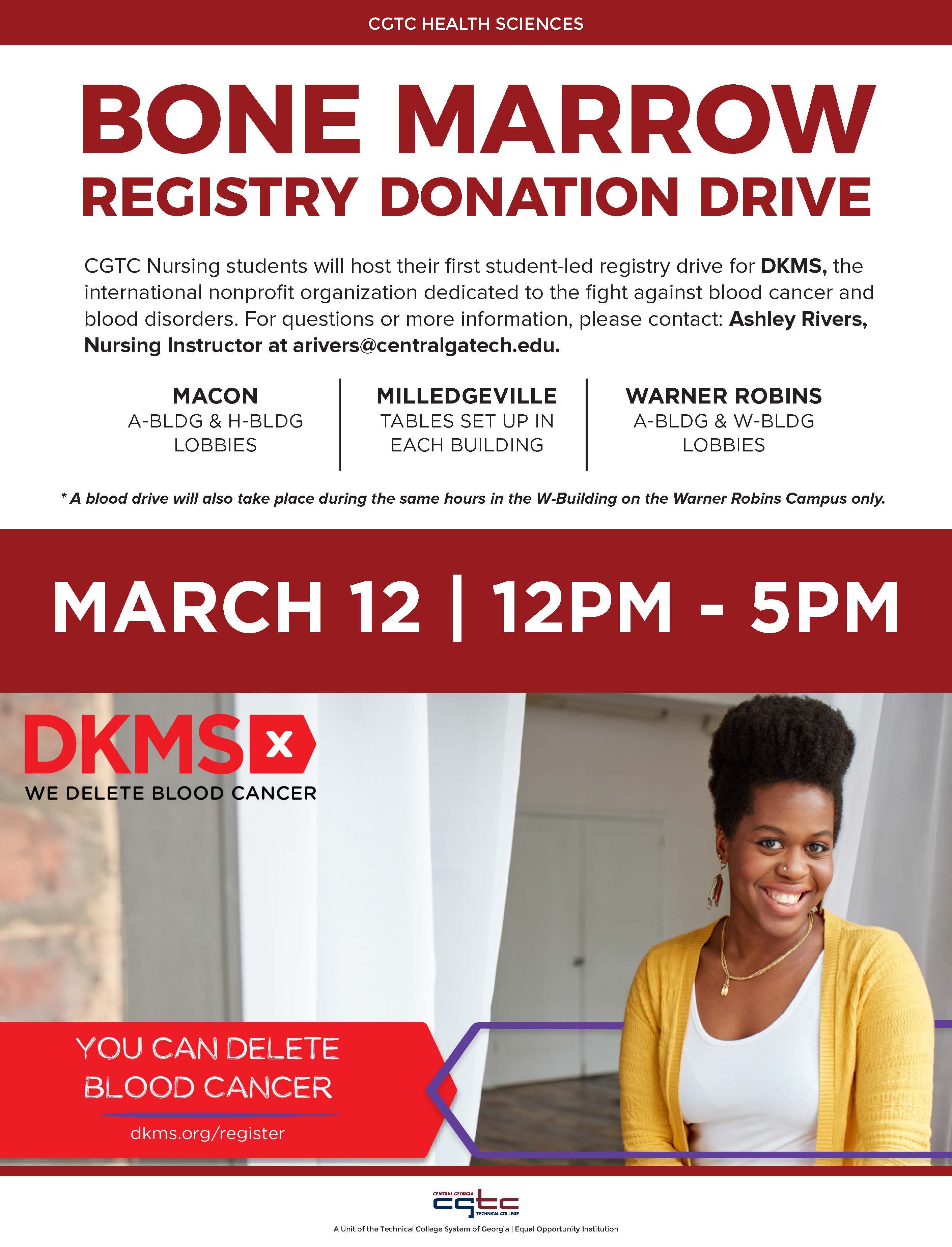Warner Robins, Ga. – There are several feelings a bone marrow donor can feel after donating; sometimes it’s a sharp pain in the lower back, or a sting from a needle, other times it is a sense of accomplishment. The latter feeling, a chronic one, is precisely the reason Ashley Rivers, a Nursing instructor at Central Georgia Technical College (CGTC), has challenged her students to help register donors for one of healthcare’s most needed requests.
On March 12, 2019, from 12 p.m. to 5 p.m., nursing students at CGTC will host its first student-led registry drive for DKMS, the international nonprofit organization dedicated to the fight against blood cancer and blood disorders.
The students will recruit donors for the DKMS registry on each of the College’s three main campuses in Warner Robins, Macon, and Milledgeville. A blood drive will also take place during the same hours on the Warner Robins location only.
Tables in the H and A-Building of the Macon campus, H-Building of the Milledgeville Campus, and W and A-Buildings of the Warner Robins campus will accommodate the registry.
In 2014, Rivers registered for DKMS while at a student-nurses conference. At the time, her husband had already been on the list and knew more about the significance of registering. He shared with her a story about how a donor helped his high school teacher’s relative who developed a blood cancer and was in need of a transplant.
He told her the likelihood of ever being called was somewhere around one percent. Rivers understood the need, registered, and forgot all about it.
In November 2016, Rivers received a phone call from DKMS telling her that she was a match for a 43-year-old male in London who suffered from acute myeloid leukemia and needed a transplant.
They asked her if she was willing to donate and Rivers did not hesitate.
“I had blood tests done, urine tests, and had to inject myself with shots to stimulate extra growth of bone marrow cells,” she said. “We went forward with the bone marrow donation and I gave through peripheral blood cells. However, because my veins are very terrible – those are the doctor’s own words – I had to have a central line placement for the procedure. I suffered some nausea and some vomiting but pushed through.”
The information Rivers received about transplant recipient is limited due to patient confidentiality. The donation took place in April 2017 and the patient is still alive.
“A blood drive is simple, you make the choice to save someone’s life and the gratification is instant. You give and you are done,” Rivers said. “With bone marrow, you are signing up to possibly save someone’s life in the future and that can be a little scary.”
Although, the potential trepidation of being in the one percent of registrants who actually have to donate is real, so is the “miracle” of following through.
“I think Mrs. Rivers helped bring the donor side of the story to life,” said nursing student, Kayla Jacobs, “One of the facts DKMS is very open about is that only about 1% get called to donate, so most of the time people get put on the registry and don’t think about it again. But, Mrs. Rivers did have to think about it again, and she decided to continue with the process and give – literally – of herself to help someone else. It is moving and it makes you stop and think about the people who were potentially waiting on that list for their 1% miracle.”
In response to Rivers’ donation story, nursing students enrolled in the Foundation of Nursing courses at the College are teaming with DKMS to administer swabs for registration on the non-profit’s official registry of donors. They hope for a large response from the community, particularly people ages 18-55.
Keep in mind there is no actual bone marrow procedure for registry, just swabs on the inside of the mouth.
While the drive accounts for 10 percent of each student’s grade as a collaboration project and outreach project to the community, their enthusiasm and commitment to the project need no incentive.
Students, Stacey Evans and Kimberly Thompson, respectively said, “finding matches is the much larger and more important picture”, and that the possibility of even “one donor match” out of this community for someone in need is a success.
Student involvement with the drive and DKMS makes the Division of Nursing eligible to apply for grant funding through the non-profit organization. As a part of the qualification process, students must complete and document individual and group tasks during the planning, promoting, education, recruitment and day-of duties of the campaign.
Evans said DKMS has been extremely helpful and informative.
“Seeing how much they have been helping us, sending us equipment, and educating shows how much they really want donors and how much they truly care about helping those who are in need,” she said. Though I do not feel that the grant should be what we are focused on, it was extremely generous of DKMS to offer, and it gave some of the other students the drive to push harder to find people to register.”
DKMS will award six $1300 grants by June 14, 2019, to student organizations who are willing to work hard to organize a successful and unique donor drive. Each school will be judged against schools of a similar size in a small, medium and large category. Two grants will be given to small schools (under 5,000), two grants to medium schools (5,000 to 10,999) and two grants to large schools (11,000 and over)
The students have established a goal of over 260 registrants.
For more information contact, Ashley Rivers at arivers@centralgatech.edu.

Photo: Infographic for upcoming bone marrow registry drive at CGTC.
